




Key Concepts and Real-Life Applications
We come to encounter a variety of shapes in geometry. Among them is a triangle. To address issues involving triangles, we have various theorems at our disposal. Perpendicular bisector and angle bisector theorem are two examples. These crucial triangle theorems will be covered in this essay. A line known as a bisector divides an angle or a line into two parts of equal size. The midpoint of a segment is always contained in the segment's bisector. The perpendicular bisector theorem will be discussed first.
What is a Perpendicular Bisector?
A line segment that crosses another line segment at a right angle and splits that another line into two equal portions at its middle is known as a perpendicular bisector.
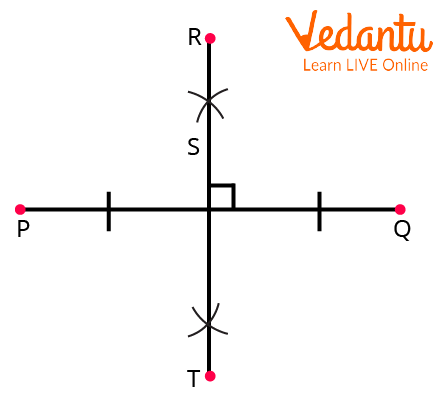
Perpendicular Bisector
What is the Perpendicular Bisector Theorem?
According to the perpendicular bisector theorem, every point on the perpendicular bisector is equally spaced from both of the line segment's endpoints.
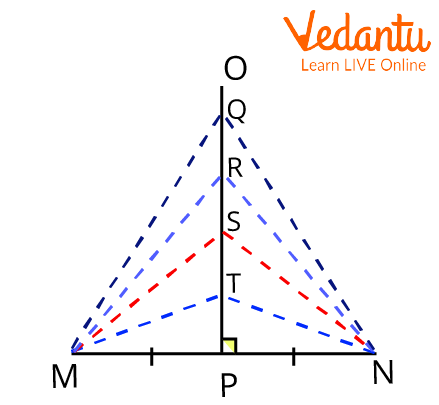
Perpendicular Bisector Theorem
In the above figure,
\[\begin{array}{l}MT\; = \;NT\;\;\\MS\; = \;NS\;\;\\MR\; = \;NR\;\;\\MQ\; = \;NQ\end{array}\]
Perpendicular Bisector Theorem Proof
Take a look at the diagram below, where C is just a random point on AB's perpendicular bisector (which intersects AB at D):
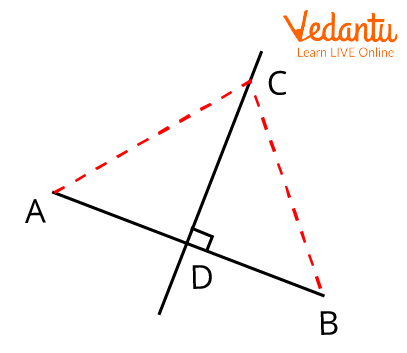
Perpendicular Bisector Proof
Compare the $\triangle ACD$ and $\triangle BCD$.
\[\begin{array}{l}AD = BD\\CD = CD(common)\\\angle ADC = \angle BDC = {90^ \circ }\end{array}\]
By the SAS rule of congruence, the triangle ACD and triangle BCD are congruent.
Hence proved.
What is Angle Bisector Theorem?
According to the Angle Bisector Theorem, the angle bisector of a triangle divides the other side in such a way that the ratio of the two line segments is equal to the ratio of the other two sides. Due to the angle bisector, the lengths of the other two triangle sides are equal to the relative lengths of the opposite side. All varieties of triangles can be analysed using the angle bisector theorem.
Angle Bisector Theorem Statement
The angle bisector theorem states that a triangle's angle bisector separates its opposite side into two pieces that are proportional to its other two sides.
Angle Bisector Theorem Proof
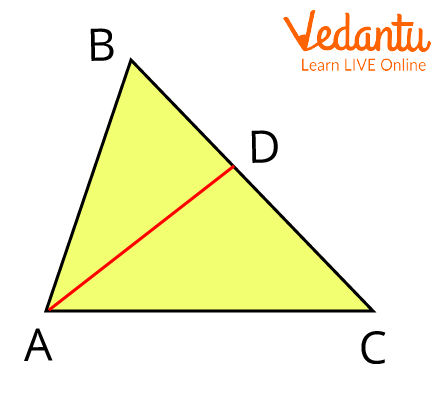
Angle Bisector Theorem Proof
By utilising trigonometry in this case, we can quickly demonstrate the angle bisector theorem. Using the law of sines, we can write the following in the triangles ABD and ACD (in the preceding diagram);
\[\begin{array}{l}\dfrac{{|AB\lvert}}{{|BD\lvert}}\; = \dfrac{{\;\sin \angle BDA}}{{\sin \angle BAD}}\;\;\; \ldots \left( 1 \right)\\\dfrac{{|AC|}}{{|DC|}}\; = \dfrac{{\;\sin \angle ADC}}{{\sin \angle DAC}}\;\;\; \ldots \left( 2 \right)\end{array}\]
Angles ∠ ADC and ∠ BDA are referred to as adjacent supplementary angles since they form a linear pair.
Due to the sine of supplementary angles being equal,
\[\sin \;\angle \;BDA\; = \;\sin \;\angle \;ADC\;\;\;\;\; \ldots ..\left( 3 \right)\]
Also,
\[\angle \;DAC\; = \;\angle \;BAD\;\](Since AD is an angle bisector)
Therefore,
\[\sin \;\angle \;BDA\; = \;\sin \angle \;ADC\;\;\;\; \ldots \left( 4 \right)\]
Since the RHS of equations 1 and 2 are equal, it follows that the LHS will likewise be equally based on equations 3 and 4.
\[\dfrac{{\left| {BD} \right|}}{{\left| {DC} \right|}} = \dfrac{{\left| {AB} \right|}}{{\left| {AC} \right|}}\]
Hence Proved.
Applications of the Perpendicular Bisector and Angle Bisector Theorem
A triangle's lengths can also be determined using the perpendicular bisector theorem in combination with other theorems.
Due to the fact that an angle bisector divides the side opposite the angle into two segments proportional to the triangle's other two sides, the Angle Bisector Theorem aids in determining the lengths of sides of triangles that are unknown.
Interesting Fact
Both angle bisector and perpendicular bisector theorems' converses are true as well.
Solved Examples of the Perpendicular Bisector and Angle Bisector Theorem
1. The perpendicular bisector of triangle ABC on line segment BC in a pyramid is line segment AD. Find the length of side AC if AB is 20 feet long and BD is 7 feet long.
Ans: It is assumed that AD is the line segment's perpendicular bisector on BC.
Therefore, any point on line segment AD is equally far from points B and C according to the perpendicular bisector theorem. Meaning that AB = AC.
Therefore,
\[AC\; = \;20\;feet\]
2. Can we state that the vertex between equal sides in any equilateral or isosceles triangle lies on the perpendicular bisector of the base?
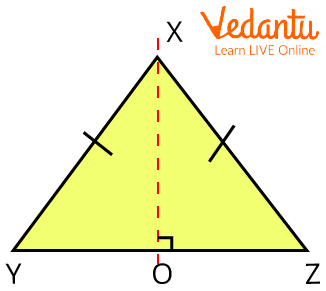
Triangle XYZ
Ans: From vertex X, create a perpendicular that intersects segment YZ at point O.
The inverse of the perpendicular bisector theorem is used to demonstrate that
\[OY = OZ\]
If \[XY\; = \;XZ\].
On the perpendicular bisector of the triangle's base, YZ is where vertex X is located.
3. Using the angle bisector theorem, determine the value of x for the given triangle.
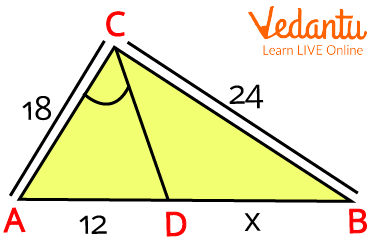
Triangle ABC
Ans: Given data,
$AD=12$, $AC=18$, $BC=24$, and $DB=X$.
By the angle bisector theorem,
\[\dfrac{{AD\;}}{{AC}} = \dfrac{{\;DB}}{{BC}}\]
Now replace the values, we get
\[\begin{array}{l}\dfrac{{12}}{{18}} = \dfrac{{\;X\;}}{{24}}\\X = \dfrac{{\;2\;}}{3}\left( {24} \right)\\X = \;2\left( 8 \right)\;\\X = \;16\end{array}\]
Therefore, the value of X is 16.
Important Points to Remember
The SAS congruence criterion can be used to demonstrate the perpendicular bisector theorem and its opposite.
In order to create something in the middle and an equal distance from each endpoint, the perpendicular bisector theorem is employed in the construction of buildings, bridges, and other structures.
Important Formulas from the Theorem
According to the perpendicular bisector theorem, if a bisector CD bisects the triangle ABC in two triangles, then
$\angle ADC = \angle BDC = {90^ \circ }$
According to the angle bisector theorem, for a triangle ABC having a bisector AD
\[\dfrac{{\left| {BD} \right|}}{{\left| {DC} \right|}} = \dfrac{{\left| {AB} \right|}}{{\left| {AC} \right|}}\]
Conclusion
The perpendicular bisector and angle bisector theorems and their explanations have been covered in-depth in this article. We may infer from the examination of these two theorems above that each of them is important to Mathematics and has a variety of implications. The theorems hold valid similarly.
FAQs on Perpendicular Bisector and Angle Bisector Theorem
1. What is the Perpendicular Bisector Theorem?
The Perpendicular Bisector Theorem states that if a point lies on the perpendicular bisector of a line segment, then it is equidistant from the two endpoints of that segment. In simple terms, any point on the line that cuts another segment in half at a 90-degree angle will be the same distance from both ends of the segment it cuts.
2. What does the Angle Bisector Theorem state?
The Angle Bisector Theorem relates the side lengths of a triangle to the segments created by an angle bisector. It states that if an angle of a triangle is bisected, the bisector divides the opposite side into two segments that are proportional to the other two sides of the triangle.
3. What is the main difference between a perpendicular bisector and an angle bisector in a triangle?
The primary difference lies in what they divide and their resulting properties.
- A perpendicular bisector acts on a line segment (a side of the triangle), dividing it into two equal lengths at a right angle.
- An angle bisector acts on an angle, dividing it into two equal smaller angles.
- The meeting point of perpendicular bisectors is the circumcenter (equidistant from vertices), while for angle bisectors, it is the incenter (equidistant from sides).
4. What is the converse of the Perpendicular Bisector Theorem?
The converse of the Perpendicular Bisector Theorem reverses the logic. It states that if a point is equidistant from the two endpoints of a line segment, then it must lie on the perpendicular bisector of that segment. This is often used in proofs to establish that a specific point lies on a bisector.
5. How is the Angle Bisector Theorem applied to find unknown side lengths?
The theorem provides a formula based on ratios. For a triangle ABC, if AD is the angle bisector of angle A and meets side BC at D, then the ratio of the sides adjacent to the angle is equal to the ratio of the segments the bisector creates on the opposite side. The formula is AB/AC = BD/DC. If you know any three of these four lengths, you can solve for the unknown one.
6. Where do the perpendicular bisectors of a triangle's sides meet?
The three perpendicular bisectors of the sides of a triangle are concurrent, meaning they all intersect at a single point. This point of concurrency is called the circumcenter. The circumcenter is unique because it is equidistant from all three vertices of the triangle, making it the center of the circumcircle which passes through all three vertices.
7. Why are these theorems crucial for understanding a triangle's circumcircle and incircle?
These theorems are fundamental to two of the most important points of concurrency in a triangle.
- The Perpendicular Bisector Theorem and its converse justify the existence of the circumcenter, the point equidistant from all vertices, which is necessary to define and construct the circumcircle.
- The Angle Bisector Theorem justifies the existence of the incenter, the point equidistant from all sides, which is the center of the triangle's incircle (the largest circle that fits inside the triangle).
8. What does the converse of the Angle Bisector Theorem state?
The converse of the Angle Bisector Theorem states that if a point D on the side BC of a triangle ABC divides BC such that the ratio of the segments BD/DC is equal to the ratio of the other two sides AB/AC, then the line AD is the bisector of the angle A. This is used to prove that a line is an angle bisector.































